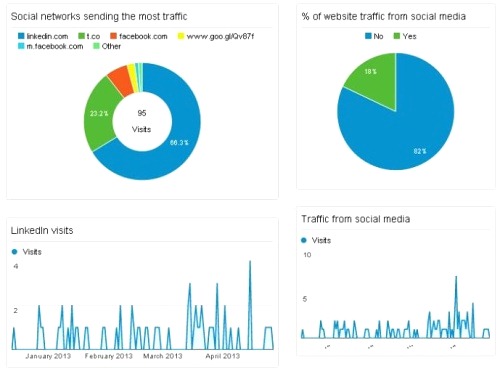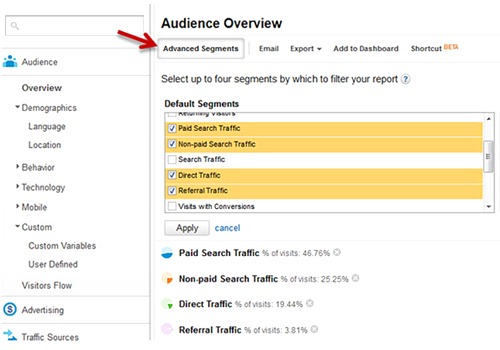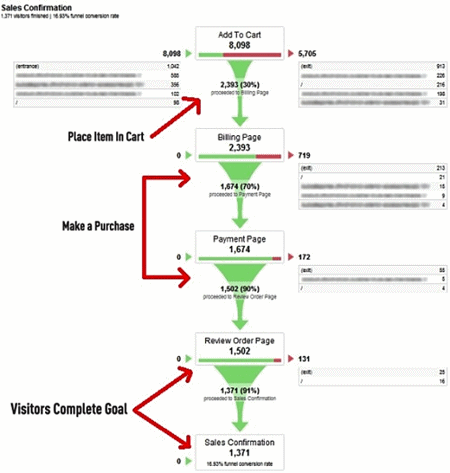5 Crucial Google Analytics Customizations to Boost Ecommerce Sales
This is a guest post by Kinjal Adeshara.
An ecommerce site is an excellent way of generating revenues with minimum physical efforts. But that doesn’t mean it can thrive on its own. Tools like Google Analytics are survival keys for ecommerce sites – access to data and ability to analyze it are the foundation on which successful online stores are built. Study of web analytics report from Google Analytics can help you to get useful insights in important factors like identification of campaigns that are actually working, pages that are getting maximum attention, and products that get minimum response from customers.
However, in order to get all kinds of extensive metrics regarding the store, you will need to customize certain core areas of Google Analytics. Doing so will help you to boost your sales, and it will also aid in increasing its overall value for customers. So, get ready to make the most of your ecommerce site with these five crucial customizations in Google Analytics.
1. Custom Reports
 You already get a few default native reports from Google Analytics in your account. Such reports can be found on the left hand column. Mostly, they offer stats on top landing pages and traffic sources. But, if you wish to get more detailed reports, you need to use Custom Reports. You can find Custom Reports on the top navigation menu.
You already get a few default native reports from Google Analytics in your account. Such reports can be found on the left hand column. Mostly, they offer stats on top landing pages and traffic sources. But, if you wish to get more detailed reports, you need to use Custom Reports. You can find Custom Reports on the top navigation menu.
Here, select ‘Create a Custom Report’ option. When you select it, you’ll get additional options like Metric Groups and Dimension Drill-downs. Metric Groups can give you the numbers for average visit duration, ecommerce conversion rate and pages/visit. Dimension Drilldowns on the other hand can track figures from source/medium and keyword. This will help you to get accurate figures that are pretty helpful when you’re running SEO and PPC campaigns.
2. Customization in Advanced Segments
 Advanced Segments is a must-use for ecommerce merchants. Google Analytics does provide you stats on traffic, but those stats are clumped. You won’t be able to know which sources are actually bringing more clicks and which ones need more attention. But with Advanced Segments, isolating specific data and analyzing useful traffic sources becomes easy. You can customize this feature in the two ways:
Advanced Segments is a must-use for ecommerce merchants. Google Analytics does provide you stats on traffic, but those stats are clumped. You won’t be able to know which sources are actually bringing more clicks and which ones need more attention. But with Advanced Segments, isolating specific data and analyzing useful traffic sources becomes easy. You can customize this feature in the two ways:
- Segment by Traffic Channel
Segmenting reports by traffic channel will enable you to assess traffic generation via different sources. You can get exact numbers from ‘Traffic Sources’ option. Ranging from emails to organic searches, it will give you figures from all sources that you’re using to get customers. Further, these figures will help you to analyze your marketing campaigns.
For example, if find out that your social media campaign is bringing great results for you, then you should look forward to expand this channel. But if it is performing poorly, then a great deal of attention should be given here.
- Segment by Day of Week
Feature to segment reports by day of the week is highly beneficial for ecommerce merchants. You can you set up custom reports by days of weeks, you get to see number of visits, ecommerce conversion rate and revenue generated each day.
So, if you see Sunday getting maximum number of conversions, then it’s an indication that Sunday is a good time to display special offers and discounts. The gathered data from report segmentation can come in well handy to amplify sales and success of your site.
3. Funnels
 In a layman’s words, you can call funnels as ways that help online merchants to check performance of an entire process via URLs. An example will make this clearer. Suppose you want to know how satisfied your customers are with your site’s shopping process. For this, you can create a funnel that starts with ‘Add to Shopping Cart’ and ends at ‘Payment Successful’ page. Through funnel segmentation, you can find out performance of each and every single step.
In a layman’s words, you can call funnels as ways that help online merchants to check performance of an entire process via URLs. An example will make this clearer. Suppose you want to know how satisfied your customers are with your site’s shopping process. For this, you can create a funnel that starts with ‘Add to Shopping Cart’ and ends at ‘Payment Successful’ page. Through funnel segmentation, you can find out performance of each and every single step.
You’ll be able to figure out number of people leaking out at different stages. For viewing completion percentage of every step of a funnel, go to Conversions > Goal Flow Reports. Here, select ‘Medium’ in the dimension drop down. This will enable you to check performance of every step via traffic channel. Though you can find several funnel segmentation ideas, here are some useful ones for your ecommerce sites.
- Add-to-Cart conversions: Setting this up in Google Analytics as a funnel can aid in tracking campaign response as well as conversions. You’ll be able to know which products are added to shopping carts.
- Track Repeat Buyers: Setting up this funnel in Google Analytics will help in identifying shopping behavior of your valuable set of customers by monitoring conversion rates and their average order values. You can set up same metrics for first time buyers and then compare these two reports. The comparison will help you to pick out differences between shopping trends, and you will be able to make improvements accordingly.
- Location of add-to-cart: Experienced online merchants know that home page is not the only source for adding products to carts. Recommendations in specific product page or promotion page also carries potential to motivate your customers to add products in shopping cart. Knowing those specific locations and how customers use them, is certainly worth knowing, as it will help you to design better promotional pages.
4. Goal Conversions
 If you’re not measuring goal conversions, then you are missing out on measuring success of your site. Thanks to Google Analytics, with a little customization, you can measure performance of well-defined Goals. However, in order to do so, you first need to define actions for which you would like to track conversions. Listed below are the four types of Goals that can be tracked in Google Analytics.
If you’re not measuring goal conversions, then you are missing out on measuring success of your site. Thanks to Google Analytics, with a little customization, you can measure performance of well-defined Goals. However, in order to do so, you first need to define actions for which you would like to track conversions. Listed below are the four types of Goals that can be tracked in Google Analytics.
- URL Destination: Goal conversions are recorded for specific URLs like Payment Successful page or Shopping Cart page.
- Pages per Visit: This goal records the number of pages that a visitor views in a single visit, for example, two or four pages in one single visit.
- Visit Duration: This goal records visitors who linger on specific pages for a certain time period like 120 seconds (2 minutes).
- Event: Goal under this category is recorded only when specific event occurs, for example, when a visitor clicks email subscription button or feedback button. However, implementation of this goal need some technical skills. So, it is better to get thoroughly used to with Google Analytics before tampering with this feature. Or, you could get your developers or tech-savvy members of the staff to set it up for you.
5. Ecommerce Tracking for Mobile Apps
![]() In the smartphone era, an online merchant simply can’t ignore the potential of m-commerce. So, if you have supplied your customers with a mobile app, then you should use Google Analytics Android SDK or Google Analytics iOS SDK to track transaction data for your mobile apps. However, you won’t need SDK’s for mobile web pages because the Google Analytics tracking code works same for desktop as well as smartphone browsers.
In the smartphone era, an online merchant simply can’t ignore the potential of m-commerce. So, if you have supplied your customers with a mobile app, then you should use Google Analytics Android SDK or Google Analytics iOS SDK to track transaction data for your mobile apps. However, you won’t need SDK’s for mobile web pages because the Google Analytics tracking code works same for desktop as well as smartphone browsers.
Conclusion
You can obtain useful, extensive metrics from Google Analytics. A study of the different figures can help you tweak your store, improve your process and eventually increase ROI of your ecommerce site. But, for this, you will require proper configuration of the above mentioned features. In addition, you’ll also need to monitor reports thoroughly after setup – the benefits will trickle down, but with time. So, the sooner you start with customization, the faster you’ll reap the rewards.
About the author
Kinjal Adeshara has been helping ecommerce website owners improve efficiency of their websites and boost sales since last 5 years. Currently, she is working with Cygnet Infotech, an ISO Certified company providing end-to-end ecommerce solution to business worldwide. You can connect with Kinjal on Google+.
12 comments to "5 Crucial Google Analytics Customizations to Boost Ecommerce Sales"
great post... will be applying this to my analytics
I think it is really important for use all these analytics, but ultimately everyone want to make more money, then my first preference in 2014 is Google Sniper 2
Thanks
Seems alike an approach using in Google analytic nah..??Thank you bloggersentral for the article..
Hi Kinjal, This is really a nice blog posts. I never know about these customizations, But must say, informative posts. Thanks you.
I really never knew about segment reports. Thanks for the good share..Keep it up.
Hi Kinjal, I am really impressed by your writing skills. The way of presentation is damn good. Thanks for the list of customizations, I will surly try them.
Wow I didn't know that analytics had this features, all I am using for this is the views count on my blogs HAHA.. thanks for this good info.
Thanks lava for this eye opening use of analytics, never thought that this has many features including those mentioned.
Okay, still looks a bit complex to me, especially the funnels part
still learning about google analytics.. thanks, this help me..
this is very nice article about analytics... they are extremely helpful... of course it was better when we could also see the keyword searched by the client!!! i hope it comes back!
Hey great blog post dear, i hope it will help many new bloggers
Post a Comment
We love to hear from you! Leave us a comment.
To ensure proper display, HTML/XML/Javascript need to be escaped first using this escape tool.